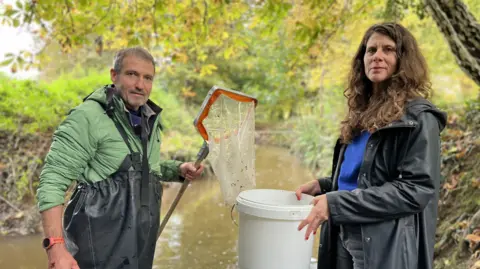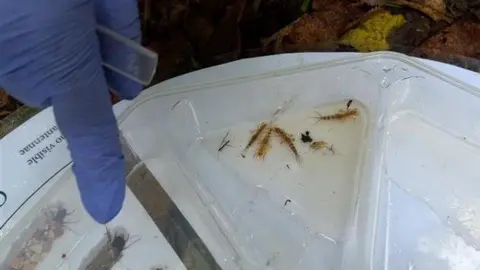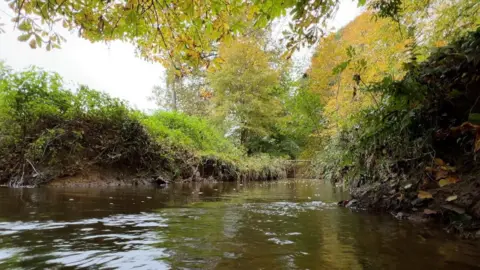'Grim is a good word to explain this site'
 Charlie Rose/BBC
Charlie Rose/BBCA favourite of period dramas, Groombridge Place has remained relatively unchanged for centuries.
It’s a picture-postcard Kent scene but the health of the River Grom that flows past the old manor house, and feeds its moat, appears to be struggling.
Volunteers from Project Ripple Effect, who are concerned about the state of rivers, are testing the water quality of the Grom after reports of reduced biodiversity.
The Environment Agency said all information received from the public on water quality was helpful.
Co-founder of the volunteer group, Sarah Butler, said: “If you talk to people who grew up here, who are in their 70s and older, there used to be eels, trout and stickleback. You don’t see them now.”
Every fortnight the volunteers test for chemicals in the water, and once a month for invertebrates by kicking up what is in the river bed.
“I’ve met a whole load of anglers who told me that the moment the Grom enters the main Medway, the quality of the water in the Medway plummets, the wildlife plummet,” Ms Butler added.
“So I knew that we really needed to try to find out more about what was going on in this particular five-mile stretch of river.”
In Groombridge, the group said they were excited to find several mayfly larvae, key indicators of healthy water.
Ellie Rotheray, a senior lecturer in ecology and evolution at the University of Sussex, helps the group gather data using strict scientific methods.
“Mayflies are intolerant to pollution, so finding them here in this sample means that the site is relatively healthy,” she said.
'Exposed to lots of chemicals'
But two miles upstream in Tunbridge Wells, it’s a different story.
In an area of woodland, volunteers have found a manhole which they say spews a torrent of rainwater mixed with untreated sewage during storms or prolonged wet weather.
A video filmed in September appears to show water gushing from the manhole and into this part of the Grom.
“Grim is a good word to explain this site. It just looks like in it’s in a mess,” Ms Rotheray said.
"It looks like it’s been abused. It’s just clearly exposed to lots of chemicals.”
Southern Water, which is partly responsible for Rivers Grom and Medway, said they were aware of a faulty manhole which had suffered root damage, and that teams were working on a long-term solution.
 BBC / Charlie Rose
BBC / Charlie RoseThe Project Ripple Effect group also monitors two other stretches of river feeding the Medway, including a section flowing from the Ashdown Forest, near Forest Row, and another at Hartfield.
Data they collect is passed on to the Environment Agency.
The volunteers said after they reported very high levels of ammonia in the Grom at Groombridge in October, they suspect the agency took action by installing their own monitoring equipment at the site.
 BBC / Charlie Rose
BBC / Charlie RoseSouthern Water said they were strong supporters of citizen science initiatives.
“Since the Medway hasn’t been studied, there’s a lot of data that is missing. So we are actually creating a baseline so we have something to compare with,” said Lucila Newell, a lecturer in geography at the University of Sussex.
“Even in the six months we’ve been testing, we have seen instances of pollution and where there is pollution there is a reduced biodiversity.”
Follow BBC Kent on Facebook on X and on Instagram. Send your story ideas to [email protected].
